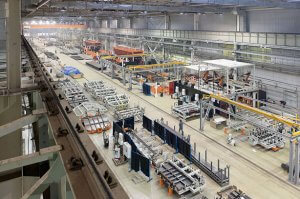5 Benefits of Nearshoring to Mexico
05.25.21 Nearshoring has become a top strategy for U.S. manufacturers that want to relocate their facilities from China and bring their operations closer to home in Mexico. As with offshoring, the goal of nearshoring is to create a more cost-effective solution through lower labor and facility costs. However, nearshoring to Mexico provides far more benefits due to the close proximity to the U.S.
Nearshoring has become a top strategy for U.S. manufacturers that want to relocate their facilities from China and bring their operations closer to home in Mexico. As with offshoring, the goal of nearshoring is to create a more cost-effective solution through lower labor and facility costs. However, nearshoring to Mexico provides far more benefits due to the close proximity to the U.S.
Here is a list of five benefits of nearshoring to Mexico that highlights why many U.S. manufacturers are considering making the operational move from China or expanding their operations internationally for the first time.
#1: Faster Shipping Times and Similar Time Zones
Mexico’s geographical location provides a significant advantage over offshoring to China. The close proximity to the U.S. creates the opportunity for faster delivery and less costly shipping. In many cases, if your operations are located in one of Mexico’s border cities, you can receive shipped goods on the same day at their final destination in the U.S. The same type of shipment can take two to three weeks when being sent from China.
Also, by working in similar time zones, it allows for more seamless communication and fewer interruptions in the day-to-day workflow. Whereas, offshoring production to China is challenged by a 16-hour time difference between America’s West Coast and China.
Read more: Why companies are switching from China to Mexico for manufacturing.
#2: Frequent Visits and Greater Oversight on Quality Assurance
Another benefit of nearshoring to Mexico is it allows for more frequent visits from managers who want to oversee the process or come in and make changes. Travel to Mexico doesn’t require too much planning. For many, a round-trip from the U.S. to Mexico can be conducted in a single day versus the logistics that go into scheduling a trip to China.
When there is a decline in quality or new production is being introduced, the closer location allows problems to be fixed more quickly with regular site visits scheduled when necessary.
Read more: 3 things to consider when moving manufacturing from China to Mexico.
#3: Improved Control Over Intellectual Property Protection
The ongoing trade conflict between the U.S. and China has been a turning point for many manufacturers who seek more stability for their operations. This involves tariff negotiations and intellectual property protection, areas where the U.S. has struggled in dealing with China. Fortunately, with the USMCA intact, there are provisions that protect manufacturers’ intellectual property, across the North American region, which makes nearshoring to Mexico a more secure solution.
#4: VAT Tax Exemption on Temporary Imports Under the IMMEX Program
One of the benefits unique to Mexico is the IMMEX maquiladora program. This program offers favorable tax benefits to foreign manufacturers operating in Mexico. Operators approved under the IMMEX maquiladora program are exempt from the 16 percent value-added tax when importing raw goods, equipment, and materials used for manufacturing.
This is a significant cost-savings when compared to retaliatory tariffs imposed by China. Furthermore, those that choose to work with a Mexico shelter services provider can operate with its maquiladora licenses and receive this tax exemption starting from day one.
Read more: Why nearshoring to Mexico is more beneficial now than ever.
#5: Partnering with a Mexico Shelter Company
Nearshoring to Mexico already provides benefits not applicable when offshoring to China due to location alone. However, there’s also the advantage for U.S. manufacturers to work with an experienced Mexico shelter company. The benefits of Mexico shelter services include but aren’t limited to: minimized legal risk and liability, reduced labor and infrastructure costs, and a reduced learning curve when establishing permits, recruiting and hiring employees, and maintaining the correct protocol culturally and legally.
In essence, partnering with a shelter service provider lifts the burden of handling all the administrative tasks associated with setting up a new operation. Plus, production launch is much quicker with a three- to four-month timeline versus the six to seven months or more, it can take when setting up a new standalone entity.
